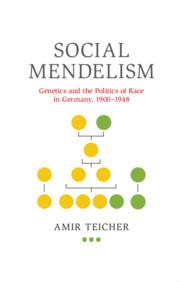Book contents
- Social Mendelism
- Social Mendelism
- Copyright page
- Dedication
- Epigraph
- Contents
- Figures
- Acknowledgments
- Abbreviations
- Introduction
- 1 Mendel’s Laws and Their Application to Humans, 1865–1913
- 2 Mendelism Maturing: From Experimental to Interpretative Framework, 1913–1933
- 3 Mendelism, Purity and National Renewal
- 4 Annihilating Defective Genes: Mendelian Consciousness and the Sterilization Campaign
- 5 Mendelizing Racial Antisemitism
- Epilogue: Social Mendelism beyond the Nazis
- Bibliography
- Index
5 - Mendelizing Racial Antisemitism
Published online by Cambridge University Press: 03 February 2020
- Social Mendelism
- Social Mendelism
- Copyright page
- Dedication
- Epigraph
- Contents
- Figures
- Acknowledgments
- Abbreviations
- Introduction
- 1 Mendel’s Laws and Their Application to Humans, 1865–1913
- 2 Mendelism Maturing: From Experimental to Interpretative Framework, 1913–1933
- 3 Mendelism, Purity and National Renewal
- 4 Annihilating Defective Genes: Mendelian Consciousness and the Sterilization Campaign
- 5 Mendelizing Racial Antisemitism
- Epilogue: Social Mendelism beyond the Nazis
- Bibliography
- Index
Summary
Mendelian notions left a clear mark on the legislation of the 1935 Nuremberg Laws, the most important anti-Jewish legislation during the Third Reich. Degrading the status of Jews to second-class citizens, the Nuremberg Laws also redefined who was to be considered a Jew, half-Jew, quarter-Jew or German-blooded. These definitions were not only informed by Mendelian reasoning; they were also propagated as such. This was true in the public domain, and found explicit manifestation in German high schools, where Mendelism and racial theory were intimately intertwined, in complex and surprising ways. As opposed to the ruling assumption in current historiography, which portrays racial diagnosis as lacking any biological logic, the praxis of racial diagnosis was also influenced by Mendelian assumptions. Finally, Mendelian anxieties about the re-coupling of recessive Jewish traits shaped Nazi policies toward the Jewish Mischlinge. These biological anxieties, shared by Nazi leaders up to Hitler himself, successfully merged with prior and even competing modes of anti-Jewish hatred, to yield a radical policy against the Jewish Mischlinge.
- Type
- Chapter
- Information
- Social MendelismGenetics and the Politics of Race in Germany, 1900–1948, pp. 165 - 204Publisher: Cambridge University PressPrint publication year: 2020

